
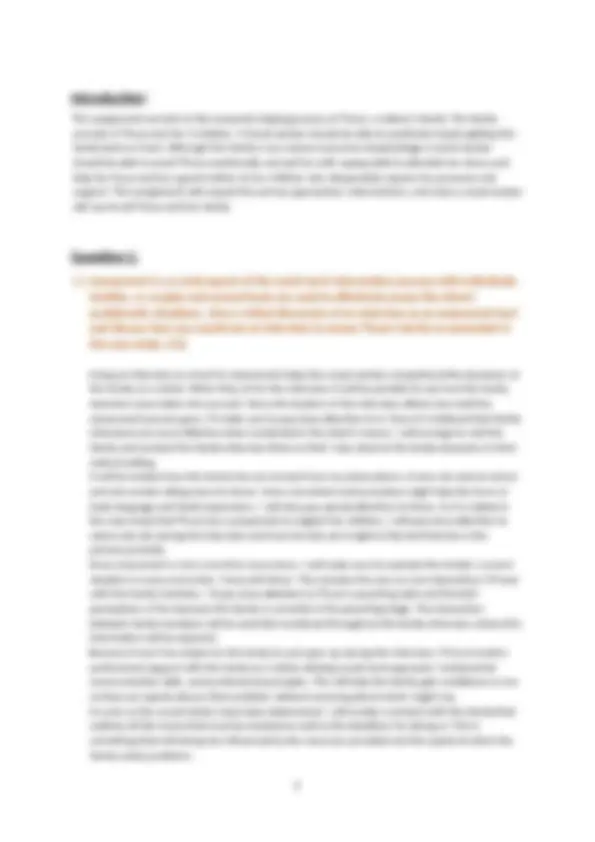
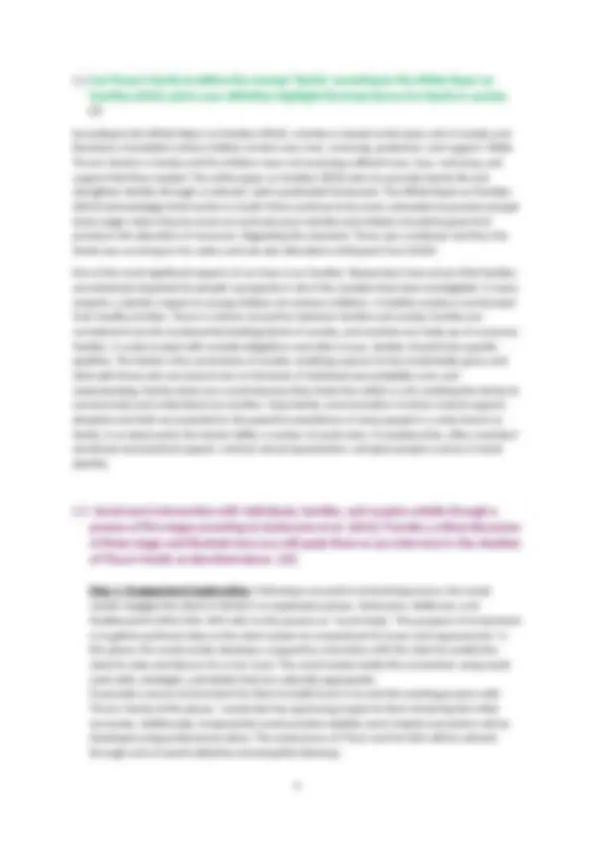
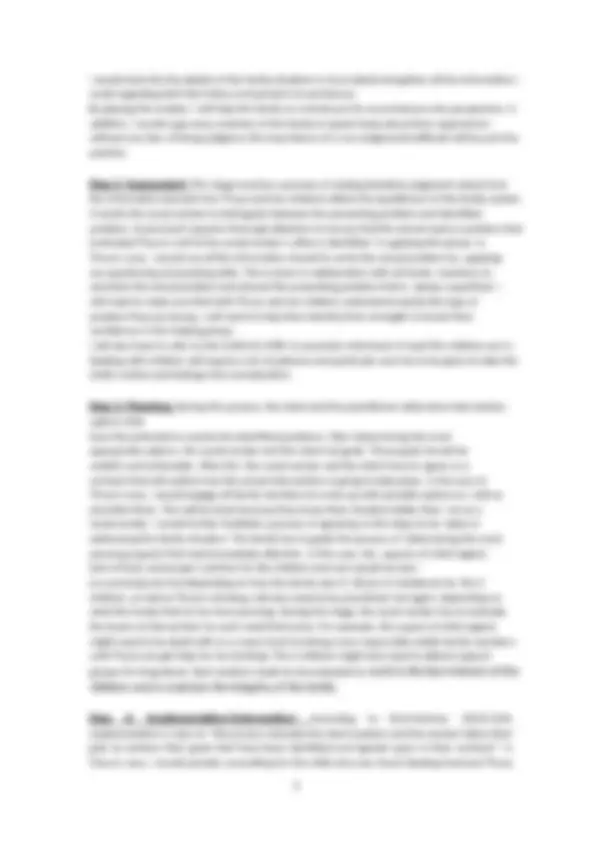
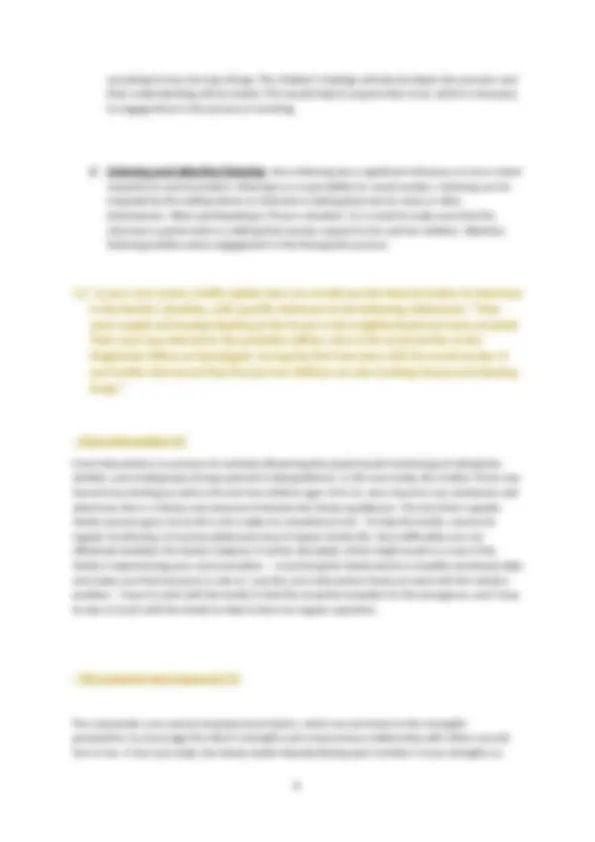
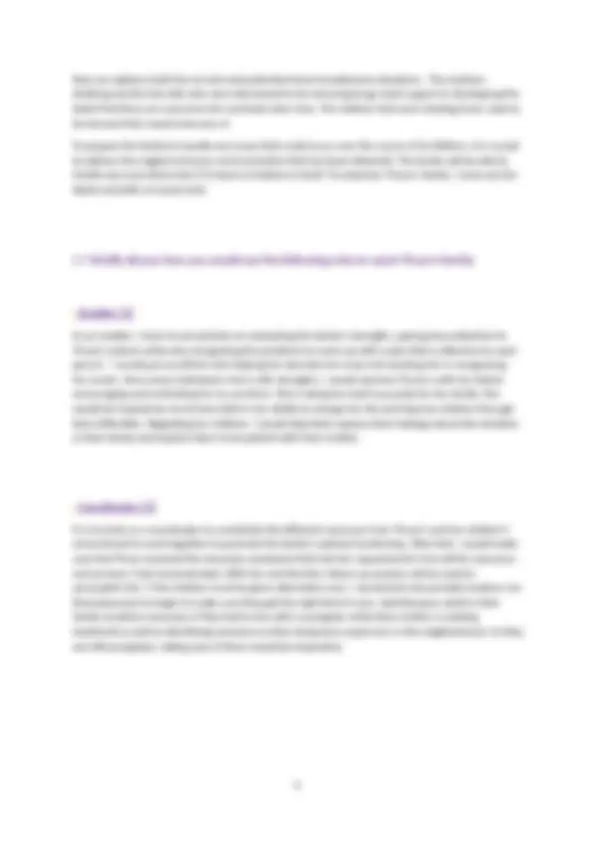
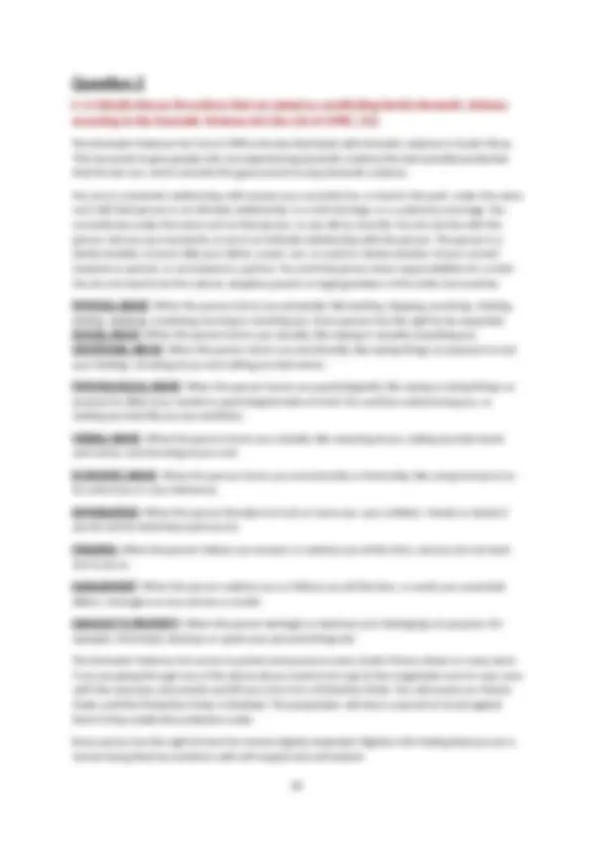


Study with the several resources on Docsity

Earn points by helping other students or get them with a premium plan


Prepare for your exams
Study with the several resources on Docsity

Earn points to download
Earn points by helping other students or get them with a premium plan
Community
Ask the community for help and clear up your study doubts
Discover the best universities in your country according to Docsity users
Free resources
Download our free guides on studying techniques, anxiety management strategies, and thesis advice from Docsity tutors
A case study of a family and discusses the social work intervention process with families. It covers topics such as assessment tools, defining the concept of family, stages of social work intervention, conditions that confirm a child is in need of care, and communication skills. The document also provides a detailed plan of action for the case study family and discusses the evaluation process.
Typology: Assignments
1 / 12

This page cannot be seen from the preview
Don't miss anything!







According to the White Paper on Families (2012), a family is viewed as the basic unit of society and therefore a foundation where children receive care, love, nurturing, protection, and support. While Thuso's family is a family unit the children were not receiving sufficient care, love, nurturing, and support that they needed. The white paper on families (2012) aims to promote family life and strengthen families through a coherent, well-coordinated framework. The White Paper on Families (2012) acknowledges that women in South Africa continue to be more vulnerable to poverty and get lower wages when they do access to work also poor families and children should be given first priority in the allocation of resources. Regarding the casework, Thuso was a widower and thus the family was surviving on her salary and was also allocated a child grant from SASSA. One of the most significant aspects of our lives is our families. Researchers have shown that families are extremely important to people's prosperity in all of the societies they have investigated. In many respects, a family's impact on young children can endure a lifetime. A healthy society is constructed from healthy families. There is a direct connection between families and society, families are considered to be the fundamental building blocks of society, and societies are made up of numerous families. In order to deal with societal obligations and other issues, families should have specific qualities. The family is the cornerstone of society, enabling a person to live contentedly, grow, and stick with those who are close to her on the basis of individual accountability, love, and understanding. Family values are crucial because they foster ties within a unit, enabling the family to communicate and understand one another. Importantly, communication involves mutual support; discipline and faith are essential for the peaceful coexistence of many people in a unity known as family. In an ideal world, the family fulfills a number of social roles. It socializes kids, offers members' emotional and practical support, controls sexual reproduction, and gives people a sense of social identity.
worker engages the client or family in an exploratory phase. Ambrosino, Heffernan, and Shuttlesworth (2012:106–107) refer to this process as "social study." The purpose of involvement is to gather pertinent data on the client system to comprehend its issues and requirements. In this phase, the social worker develops a supportive connection with the client to enable the client to relax and discuss his or her issue. The social worker builds this connection using social work skills, strategies, and beliefs that are culturally appropriate. To provide a secure environment for them to build trust in me and the assisting process with Thuso's family at this phase, I would start by expressing respect to them all during the initial encounter. Additionally, fundamental communication abilities and A helpful connection will be developed using professional values. The anxiousness of Thuso and her kids will be reduced through a lot of careful attentive and empathic listening.
I would look into the details of the family situation in more detail and gather all the information I could regarding both the history and present circumstances. By playing the enabler, I will help the family as a whole put its circumstances into perspective. In addition, I would urge every member of the family to speak freely about their experiences without any fear of being judged as the importance of a non-judgmental attitude will be put into practice.
the information derived from Thuso and her children affects the equilibrium of the family system. It assists the social worker to distinguish between the presenting problem and identified problem. Assessment requires thorough attention to ensure that the actual need or problem that motivated Thuso’s visit to the social worker’s office is identified. In applying this phase in Thuso’s case, I would use all the information shared to verify the actual problem by applying my questioning and probing skills. This is done in collaboration with all family members to ascertain the actual problem and discard the presenting problem that is always superficial. I will need to make sure that both Thuso and her children understand exactly the type of problem they are facing. I will need to help them identify their strengths to boost their confidence in this helping phase. I will also have to refer to the Child Act 1989, to ascertain what level of need the children are in. Dealing with children will require a lot of patience and particular care has to be given to take the child's wishes and feelings into consideration.
options that have the potential to resolve the identified problems. After determining the most appropriate options, the social worker and the client set goals. These goals should be realistic and achievable. After this, the social worker and the client have to agree on a contract that will outline how the actual intervention is going to take place. In the case of Thuso’s case, I would engage all family members to come up with possible options as well as prioritize them. This will be done because they know their situation better than me as a social worker. I would further facilitate a process of agreeing on the steps to be taken in addressing the family situation. The family has to guide the process of determining the most pressing aspects that need immediate attention. In this case, the aspects of child neglect, lack of food, and proper nutrition for the children and care would be seen as a pressing one but depending on how the family sees it. Abuse of substances by the 2 children, as well as Thuso’s drinking, will also need to be prioritized, but again, depending on what the family finds to be more pressing. During this stage, the social worker has to evaluate the levels of intervention for each need that arises. For example, the aspect of child neglect might need to be dealt with on a macro level involving more responsible stable family members until Thuso can get help for her drinking. The 2 children might also need to attend support
implementation is seen as “the process whereby the client systems and the worker follow their plan to achieve their goals that have been identified and agreed upon in their contract”. In Thuso’s case, I would provide counselling for the child who was found stealing food and Thuso
lack of food over the weekends will have a serious negative impact on their physical and mental well-being.
performance at school, bunking classes, and substance abuse all of which point towards mental neglect. Being arrested for stealing as well as having no food over the weekends is physical neglect. Also having no adult supervision over the weekends is physical neglect.
without food over the weekends and went out drinking with her friends. This is child neglect.
communication. Therefore, it is crucial for the social worker to hear what the client is saying vocally and to watch for nonverbal cues. In this situation, I must be able to mirror what the client system picks up nonverbally to determine the message that the various family members are trying to send. Because cultural context varies from culture to culture, it is also crucial for me to be conscious of how verbal and nonverbal expressions are formed. To enable the client system to trust me with their secrets and feel that they are understood, I must embrace culturally appropriate social work practices.
condition of the client is what is meant by empathy for a social worker. Practically speaking, the social worker needs to comprehend the client's reality as they perceive it and convey that understanding to the customer with compassion (Sekudu in Schenck et al. 2015). Empathy, according to Sheafor and Horejsi (2012): 96–97, is the capacity to put oneself in the client's position. By paying close attention to the clients and actively listening to what they have to say, the social worker may show that they are aware of their sentiments and perceptions. It is crucial to have a strong client-worker connection. Using empathy, I would make sure to express my comprehension of Thuso's circumstances and feelings when I step in to help her
according to how she sees things. The children's feelings will also be taken into account, and their understanding will be shared. This would help to acquire their trust, which is necessary to engage them in the process of assisting.
responds to communication, listening is a crucial ability for social workers. Listening can be impacted by the setting where an interview is taking place due to noise or other disturbances. When participating in Thuso's situation, it is crucial to make sure that the interview is performed in a setting that conveys respect to her and her children. Attentive listening enables active engagement in the therapeutic process.
- Crisis intervention [5] Crisis intervention is a process for actively influencing the psychosocial functioning of individuals, families, and small groups during a period of disequilibrium. In the case study, the mother Thuso was found to be drinking as well as the last two children ages 14 & 16, were found to use substances and steal food, this is a family crisis because it disturbs the family equilibrium. The fact that a specific family scenario gave rise to this crisis makes it a situational crisis. To help the family, resume its regular functioning, it must be addressed since it impairs family life. Since difficulties are not effectively handled, the family's balance is further disrupted, which might result in a crisis if the family is experiencing poor communication. I must bring the family back to a healthy emotional state and make sure that everyone is safe as I use the crisis intervention theory to deal with this family's problem. I have to work with the family to find the essential remedies for the emergency, and I have to stay in touch with the family to help it return to regular operation. - The empowerment approach [5] The caseworker uses several empowerment tactics, which are anchored on the strengths perspective, to encourage the client's strengths and a harmonious relationship with others around him or her. In the case study, the family needs help identifying each member's inner strengths so
The Domestic Violence Act 116 of 1998 is the law that deals with domestic violence in South Africa. This law exists to give people who are experiencing domestic violence the best possible protection that the law can, and it commits the government to stop domestic violence. You are in a domestic relationship with anyone you currently live, or lived in the past, under the same roof with that person in an intimate relationship, in a civil marriage, or a customary marriage. You currently live under the same roof as that person, or you did so recently. You do not live with the person, but you are married to or are in an intimate relationship with the person. The person is a family member of yours (like your father, cousin, son, or aunt) or family member of your current husband or partner, or ex-husband or partner. You and that person share responsibilities for a child. You do not need to be the natural, adoptive parents or legal guardians of the child, but could be. PHYSICAL ABUSE : When the person harms you physically, like beating, slapping, punching, choking, kicking, stabbing, scratching, burning or shooting you. Every person has the right to be respected. SEXUAL ABUSE : When the person harms you sexually, like raping or sexually assaulting you. EMOTIONAL ABUSE : When the person harms you emotionally, like saying things on purpose to hurt your feelings, shouting at you and calling you bad names. PSYCHOLOGICAL ABUSE : When the person harms you psychologically, like saying or doing things on purpose to affect your mental or psychological state of mind. He could be undermining you, or making you feel like you are worthless. VERBAL ABUSE : When the person harms you verbally, like swearing at you, calling you bad words and names, and shouting at you a lot. ECONOMIC ABUSE : When the person harms you economically or financially, like using money to try to control you or your behaviour. INTIMIDATION : When the person threatens to hurt or harm you, your children, friends or family if you do not do what they want you to. STALKING: When the person follows you around, or watches you all the time, and you do not want him to do so. HARASSMENT : When the person watches you or follows you all the time, or sends you unwanted letters, messages on your phone or emails. DAMAGE TO PROPERTY : When the person damages or destroys your belongings on purpose. For example, she breaks, destroys or spoils your personal things etc The Domestic Violence Act serves to protect and preserve every South African citizen on every level. If you are going through any of the above all you need to do is go to the magistrate court in your area with the necessary documents and fill out a form for a Protection Order. You will receive an Interim Order until the Protection Order is finalized. The perpetrator will have a warrant of arrest against them if they violate the protection order. Every person has the right to have her human dignity respected. Dignity is the feeling that you are a human being that has emotions with self-respect and self-esteem.
Social workers who specialize in mental health provide assistance to people, families, and communities as they try to overcome obstacles that jeopardize their well-being and the well-being of their neighbours. Social workers can assist recovering addicts find new employment, locate affordable housing, and access appropriate mental health care, for instance, by treating a patient's substance misuse issues. The tasks of social workers in mental health include prevention, treatment, and research. Clinical social workers use their expertise, training, and knowledge to assess, identify, and treat the conditions of patients with mental illnesses. Clinical social work, in contrast to conventional psychological procedures, considers environmental and societal issues that have an impact on a client's physical, mental, and emotional well-being. Instead of addressing these difficulties in isolation, this holistic approach aims to address the underlying issues that underlie the overall mental health concerns that an individual experiences. Clinical social workers occasionally start their own private practices, enabling them to concentrate on mental health issues that fit with their interests and education. Public and private sectors exist in social work for mental health. Teamwork has always been a crucial component of excellent mental health practice that addresses the requirements of the patient. Working with co-workers who appear to have a far stronger understanding of mental health, social workers are frequently a part of a multidisciplinary system of care for mental health. In order to measure the client's impairment in their social context, social workers must take into account the client's prior mental health and social functioning.
therapeutic approaches as well the role of the social worker. It highlights the importance of good communication skills as well as crisis intervention. It includes insight into the Child Act as well as a comprehensive view of the Domestic Violence Act of South Africa. The casework included a mother Thuso, and her three children. It ends with an in-depth discussion of the role of social workers in the mental health field. In conclusion, social work is a profession that works for the betterment of society. Empowering clients, families, or groups, fosters wellbeing. Social workers work with individuals, families, or groups from various socioeconomic backgrounds. Their methods are based on a broad framework for comprehending human behavior that is provided by a number of theories and social work practice models. Practice and theory in social work complement each other and are interdependent; neither can dominate the other.